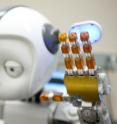How can robots get our attention?
Getting someone's attention can be easy with a loud noise or a shout, but what if the situation calls for a little more tact? How can a robot use subtle cues to attract a human's notice and tell when it has captured it? In a preliminary study, researchers at the Georgia Institute of Technology have found that they can program a robot to understand when it gains a human's attention and when it falls short. The research is being presented today at the Human-Robot Interaction conference in Lausanne, Switzerland. "The primary focus was trying to give Simon, our robot, the ability to understand when a human being seems to be reacting appropriately, or in some sense is interested now in a response with respect to Simon and to be able to do it using a visual medium, a camera," said Aaron Bobick, professor and chair of the School of Interactive Computing in Georgia Tech's College of Computing.
Using the socially expressive robot Simon, from Assistant Professor Andrea Thomaz's Socially Intelligent Machines lab, researchers wanted to see if they could tell when he had successfully attracted the attention of a human who was busily engaged in a task and when he had not.
"Simon would make some form of a gesture, or some form of an action when the user was present, and the computer vision task was to try to determine whether or not you had captured the attention of the human being," said Bobick.
With close to 80 percent accuracy Simon was able to tell, using only his cameras as a guide, whether someone was paying attention to him or ignoring him.
"We would like to bring robots into the human world. That means they have to engage with human beings, and human beings have an expectation of being engaged in a way similar to the way other human beings would engage with them," said Bobick.
"Other human beings understand turn-taking. They understand that if I make some indication, they'll turn and face someone when they want to engage with them and they won't when they don't want to engage with them. In order for these robots to work with us effectively, they have to obey these same kinds of social conventions, which means they have to perceive the same thing humans perceive in determining how to abide by those conventions," he added.
Researchers plan to go further with their investigations into how Simon can read communication cues by studying whether he can tell by a person's gaze whether they are paying attention or using elements of language or other actions.
"Previously people would have pre-defined notions of what the user should do in a particular context and they would look for those," said Bobick. "That only works when the person behaves exactly as expected. Our approach, which I think is the most novel element, is to use the user's current behavior as the baseline and observe what changes."
Source: Georgia Institute of Technology
Articles on the same topic
- How do people respond to being touched by a robot?Wed, 9 Mar 2011, 16:05:36 UTC
- How can robots get our attention?Wed, 9 Mar 2011, 4:42:56 UTC
- Teaching robots to move like humansMon, 7 Mar 2011, 16:03:38 UTC
Other sources
- How do people respond to being touched by a robot? (w/ Video)from PhysorgWed, 9 Mar 2011, 19:30:40 UTC
- How do people respond to being touched by a robotic nurse?from Science DailyWed, 9 Mar 2011, 17:31:13 UTC
- How Can Robots Get Our Attention?from Newswise - ScinewsWed, 9 Mar 2011, 16:30:51 UTC
- How Do People Respond to Being Touched by a Robot?from Newswise - ScinewsWed, 9 Mar 2011, 16:30:14 UTC
- How Do People Respond to Being Touched by a Robot?from Newswise - ScinewsWed, 9 Mar 2011, 15:30:34 UTC
- Study: Robots can understand humansfrom UPITue, 8 Mar 2011, 22:30:17 UTC
- How Can Robots Get Our Attention?from Newswise - ScinewsTue, 8 Mar 2011, 16:00:30 UTC
- How can robots get our attention?from Science BlogTue, 8 Mar 2011, 15:30:46 UTC
- Teaching robots to move like humansfrom Science DailyMon, 7 Mar 2011, 23:00:37 UTC
- Teaching robots to move like humans (w/ Video)from PhysorgMon, 7 Mar 2011, 17:31:24 UTC
- Teaching robots to move like humansfrom Science BlogMon, 7 Mar 2011, 17:30:21 UTC
- Teaching Robots to Move Like Humansfrom Newswise - ScinewsMon, 7 Mar 2011, 16:00:20 UTC
- Behind The Scenes: Robots to the Rescuefrom Live ScienceFri, 4 Mar 2011, 22:01:37 UTC
- Robots to the Rescuefrom Live ScienceFri, 4 Mar 2011, 21:00:26 UTC
- Space robot's debut being moved up after clamorfrom PhysorgFri, 4 Mar 2011, 18:30:44 UTC
- New technique for improving robot navigation systemsfrom Science DailyWed, 2 Mar 2011, 2:30:34 UTC
